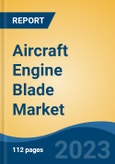Speak directly to the analyst to clarify any post sales queries you may have.
10% Free customizationThis report comes with 10% free customization, enabling you to add data that meets your specific business needs.
The demand for engines and other aviation-related components has grown significantly. As a result of this expansion, engine manufacturers are now required to produce a larger number of engines annually. Due to the increased demand caused by this reason, the market for engine blades is expanding much faster. Due to this rise in demand, businesses are adopting technologies that can reduce the overall weight and emissions of the engines to get potential customers and increase their market share. This is driving investments towards research and development in this sector. The new aircraft engines that feature considerable technological innovations are expected to make a major part of new deliveries in developing regions. The entry of new aircraft programs is propelling the development of newer aircraft engine models that are developed specifically for the new aircraft. The component and part manufacturers are expanding their production facilities, along with adopting the latest technologies, primarily to boost their production capacities.
The COVID-19 epidemic and containment efforts are resulting in a sharp decline in the demand for passenger air travel, endangering the survival of numerous businesses in the air transport sector and the rest of the aviation industry. The Covid pandemic has had a significant impact on international aircraft suppliers. As a result, restrictions have prevented the industry's recent continuous expansion. The significant increase in spending on the military sector may aid the industry's recovery, which helps recover the aircraft engine blade market.
Increasing Sales of new Aircraft and periodic replacement
On average more than 1,800 commercial aircraft were delivered to several airline operators worldwide, out of which around 40% were reportedly delivered in the Asia-Pacific region. There have been more orders placed by Qantas Airways Ltd, Air Asia, etc. Many companies are investing in new designs of blades to increase their efficiency and provide more power. Moreover, this results in the growing demand for the aircraft engine blade market. In addition, with periodic replacement of engine blades propels the market in the forecasted period.Innovation in Material Technology
The machine is the major complex part of the aircraft and consists of numerous individual factors of varying complexity. Even the simplest element design and material changes have been proven to lead to significant advancements in overall engine performance. The engines reaching 2100°C (3800°F) temperature has increased the demand for the new material system. As a result, high-temperature superalloys (HRSA), including some non-metallic mixes similar to titanium blends, nickel blends, and pottery, have been considered in engine blade manufacturing. In addition, increasing demand for lightweight, high-temperature resistant parts for engines and critical factors that contribute to energy effectiveness. These developments are anticipated to propel the growth of the aircraft engine blade market in the coming year.Complex Designs Restrict the Manufacturing
Over the course of that time, a lot of progress was made in the industry of aircraft engines. However, these advancements have brought the technology closer to its limit in terms of reliability. Under the competition, engine manufacturers are compelled to produce lighter engines with improved performance as airlines and aircraft OEMs increase their demands for thrust and efficiency. To reduce carbon emissions, engine manufacturers are developing more effective propulsion systems. Although, numerous glitches have forced many airlines to ground aircraft.Market Segmentation
The global Aircraft Engine Blade Market is segmented by aircraft type, blade type, material, end-use, and by region. Based on aircraft type, the market is segmented into Commercial Aircraft, General Aviation, Regional Aircraft, and Military Aircraft. Based on Blade Type, it is divided into Compressor Blades, Turbine Blades, and Fan Blades. Based on Material, the market is segmented into Titanium, Nickel Alloy, Composites, and others. The end Use of Aircraft engine blade market is divided into OEM and Aftermarket. The market analysis also studies the regional segmentation to devise regional market divided amongst Asia-Pacific, Europe, North America, South America, Middle East & Africa.Company Profiles
General Electric Company, CFM International, United Technologies Corporation, Rolls-Royce Holdings PLC, MTU Aero Engine, Albany International Corporation, Collins Aerospace, Arconic Inc., Pratt & Whitney, and GKN Aerospace are the key players developing advanced technologies to stay competitive in the market enhancing their product portfolio in the regions to increase their customer outreach.Report Scope:
In this report, global Aircraft Engine Blade Market has been segmented into the following categories, in addition to the industry trends, which have also been detailed below:Global Aircraft Engine Blade Market, By Aircraft Type:
- Commercial Aircraft
- General Aviation
- Regional Aircraft
- Military Aircraft
Global Aircraft Engine Blade Market, By Blade Type:
- Compressor Blades
- Turbine Blades
- Fan Blades
Global Aircraft Engine Blade Market, By Material:
- Titanium
- Nickel Alloy
- composites
- Others
Global Aircraft Engine Blade Market, By End Use:
- OEM
- Aftermarket
Global Aircraft Engine Blade Market, By Region:
- Asia-Pacific
- China
- India
- Japan
- South Korea
- Malaysia
- Indonesia
- Thailand
- North America
- United States
- Canada
- Mexico
- Europe & CIS
- Germany
- Russia
- France
- Spain
- Italy
- United Kingdom
- Poland
- Netherland
- Norway
- Middle East and Africa
- South Africa
- Saudi Arabia
- United Arab Emirates
- South America
- Argentina
- Brazil
- Colombia
Competitive Landscape
Company Profiles: Detailed analysis of the major companies present in global Aircraft Engine Blade Market.Available Customizations:
With the given market data, the publisher offers customizations according to a company’s specific needs.This product will be delivered within 1-3 business days.
Table of Contents
Companies Mentioned
- General Electric Company
- CFM International
- United Technologies Corporation
- Rolls-Royce Holdings PLC
- MTU Aero Engine
- Albany International Corporation
- Collins Aerospace
- Arconic Inc.
- Pratt & Whiteny
- GKN Aerospace








